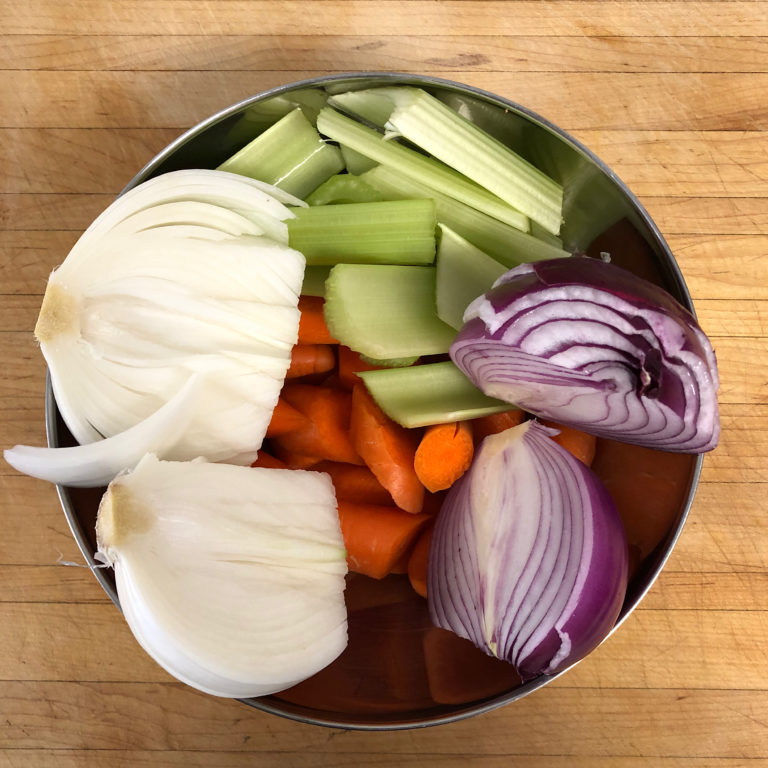How To Make Turkey Bone Broth From Your Leftover Thanksgiving Carcass
I can’t think of anything more beneficial, nutritious and comforting than a hot cup of bone broth. It is truly a miracle in and of itself, from the healing properties that come from the collagen, vitamins and minerals to the amazing taste and richness it adds to almost any dish from soups and stews to braised meats and pan sauces. I consider it to be the cornerstone of the strategy I used to overcome diverticulitis (along with Manuka honey) as it helped heal the lining in my gut and the collagen worked its magic to rebuild my intestinal tract. Learning how to make bone broth should be the number one priority of anyone trying to up their game at being the best home cook they can be and I would say that turkey bone broth is a great place to start.
Health Benefits of Bone Broth
It benefits “gut healing.” Gently simmering the bones, cartilage, and skin the collagen is broken down into gelatin and beneficial amino acids such as Glutamine and Glycine. There have been scientific studies which show that the gelatin and amino acids in bone broth can have a therapeutic effect in people who suffer from I.B.D. (Inflammatory Bowel Disease.) Glutamine is an important amino acid that is one of the “building blocks” of protein and plays a critical role in maintaining intestinal barrier integrity and your overall health.
It contains electrolytes. Electrolytes – such as Sodium, Potassium and Calcium – control your nervous system functions, regulate muscle contractions and help to balance your pH levels (the measure of acidity and alkalinity in your system.)
A veritable plethora of vitamins and minerals. Bones contain minerals such as Calcium, Magnesium, Copper, Iron, Phosphorus, Potassium, Manganese, Sodium and Zinc as well as Vitamin A, K, D, C and various forms of B-Complex (which is comprised of the eight different kinds of water-soluble B vitamins which your body cannot produce and needs to be replenished through eating.)

The Ingredients of Turkey Bone Broth
1 Whole turkey carcass (preferably at least 12-14 lb.)
2-3 Unpeeled whole yellow onions
3-4 Garlic cloves
2 Bay leaves
1 tsp. Black Peppercorns (whole)
2 tbsp. Apple Cider vinegar or fresh Lemon juice
Filtered Water (enough to cover ingredients by at least an inch or two)
Optional:
Turkey neck & giblets
Shallots
1 Leek
2-3 Carrots (peeled and cut into chunks)
2-3 Stalks of Celery (keep the leaves separate for finishing the stock, soups etc.)
Sprigs of Thyme, Rosemary or Sage
Half a bunch of Parsely

Steps to Preparing the Turkey Bone Broth
Step One: Prepare the Carcass. Pull any meat from the bones to freeze for future soups or meals being sure to leave some on the bones as they will lend great flavor to the finished stock. Pull apart or use kitchen shears to dismantle the bird enough so it fits inside your stock pot (be sure to use a pot that is at least 8 quarts.)
Step Two: Wash & Prep Vegetables. Wash and peel your carrots, slice your celery and quarter your onions (leaving the skin on.) If you are using garlic you can either peel and smash the cloves now, or wait and use them in the finish I will detail later.
Step Three: Add Filtered Water. Be sure to add enough to cover everything in the pot at least two inches. If during the cooking process the turkey or vegetables become exposed simply add more filtered water to keep them covered.
Step Four: Bring to a Boil. Once boiling reduce to a simmer as you do not want to scald the broth and ruin it. For the first hour ONLY use the turkey carcass and skim all the fat/gunk/impurities that come to the surface.
Step Five: Add the Other Ingredients. Now that you have removed most of the impurities go ahead and add the vegetables, whole peppercorns, bay leaves and the acid of your choice (apple cider vinegar or lemon juice.) Be sure to replenish the water if it dips below the ingredients to keep everything covered.
Step Six: Simmer the broth. You need to make sure it is not boiling above all other things at this stage. A gentle simmer with small bubbles peaking out of the roiling broth with peppercorns and turkey bits swimming about is what you are looking for right now. A minimum of 2-3 hours and a maximum of 6-8 hours is preferable for a poultry-based bone broth. Too little time will not extract all the flavor and nutrients and too much time can produce bitter or off-notes especially if you used garlic or herbs of a more delicate nature.
Step Seven: Strain the broth. I use a layer of cheesecloth between the two parts of the gravy separator (trap it between the lid and the body) and strain the hot broth through a fine wire mesh strainer into the separator to catch all the bits. While we skimmed most of the fat along with the impurities earlier on, the fat separator will remove the rest for a clean batch of broth.
Step Eight: The Reduction. I like to strain the hot broth into a smaller pot and reduce by at least a third and as much as half to concentrate the flavors and nutrition. This also makes it much easier to store and you can always add more water later for a lighter broth.
Step Nine: The Ice Bath. As soon as you have finished reducing your bone broth it is imperative that you cool it down enough to either be stored in the refrigerator (keeps for 2-3 days) or frozen in containers or ice cube trays (good for 6-8 months.) I pour the finished stock into my Le Creuset Dutch Oven which is sitting in the sink surrounded by ice cubes. If you need to cool the broth rapidly, add some water to the ice bath and swirl it around the outside of the dutch oven while simultaneously stirring the broth in the opposite direction to bring the heat down quickly.

Using Garlic in Turkey Bone Broth
Garlic (Allium sativum) has been long recognized for its medicinal qualities dating back all the way to 3000 B.C. It has amazing antimicrobial, anticancer and antioxidant activity as well as the ability to reduce cardiovascular disease and boost the immune system. At this point in my life, I have made bone broth more than a hundred times (not exaggerating here) and I have come to the conclusion that if you want to impart the broth with a stronger garlic flavor and retain the most nutritional benefits from it, you must add the garlic at the end when you are reducing the broth down to concentrate it. I first smash the garlic cloves with the blade of my knife and then chop them into tiny pieces. Allicin, the most biologically active organosulfuric compound found in garlic, is actually produced when the tissue is damaged (by chopping, cutting or smashing) so it is best to chop it up about 10-15 minutes prior to using it in the broth. Some people favor using a microplane to reduce the bulb to finer consistency and to release the maximum amount of Allicin. In order to maximize the beneficial compounds retained, garlic should be consumed raw, however that is not really practical since we are adding it to a hot broth. So in order to get the most nutritional benefits, I add the finely chopped or minced garlic to a drawstring Muslin bag along with any of the more delicate herbs or leaves I’m using (such as celery leaves or chive blossoms) and swirl it around in the broth for 5-10 minutes during the reduction phase right before cooling everything down in the ice bath. The active constituents in garlic that have the greatest health benefits are destroyed by intense heat so the longer it is exposed to high temperatures the less anticancer and antimicrobial activity it will retain. If you are not concerned with doing this extra step to attempt to maximize the nutritional content, just add several smashed garlic cloves with the other ingredients before the Simmering step.

Preserving Your Turkey Bone Broth
Now that you are finished with all that hard work, the last thing you want is for it all to go to waste! While a lot of people say that the broth will keep for as long as 4-5 days in the fridge, I never go more than 2-3 days without using it up. For any longer time period than that, I recommend you freeze the broth. I use a combination of 2 cup screw lid storage containers and ice cube trays to freeze the broth. My favorite trick, especially with broth that has been reduced by half to be very concentrated, is to freeze it in these silicon ice cube trays. Once frozen, simply remove the cubes and put them in a gallon size Ziploc bag to store in the freezer. This method makes it very easy to add some taste or nutrition to any meal quickly. Just put a few cubes in a measuring cup with a little water and microwave for a hot cup of broth anytime. They are also perfect for adding to your instant Ramen soup to add extra protein and nutrients.


